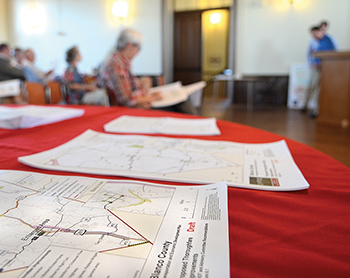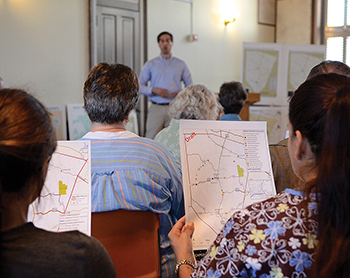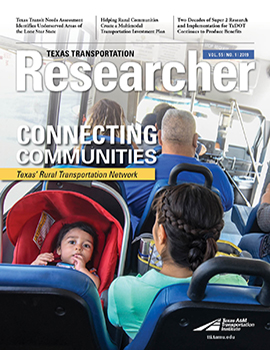The peace and quiet rural Texas is known for can sometimes contribute to the notion that a quiet life in the country means that no problems exist. Yet many Texans who enjoy country living still have mobility needs, and that tranquil image can make it difficult for rural transportation providers to secure funding to meet residents’ needs.

“The challenge for rural transportation districts is that they often don’t have the traffic congestion issues so common to urban areas with metropolitan planning organizations, and that’s where most of the funding is concentrated,” points out Darcie Schipull, strategic initiative liaison for the Texas Department of Transportation (TxDOT). “That’s why rural areas need to have a plan in place to prioritize various projects that are important in their communities.”
A starting point for those rural areas could very well be the examination of the work done by Research Scientist John Overman at the Texas A&M Transportation Institute (TTI) as part of a TxDOT project. Published in 2017, the Rural Performance Based Planning Guidebook is a key product of that initiative.
“We began working on the project and writing the guidebook in anticipation of the Moving Ahead for Progress in the 21st Century Act [MAP-21], the federal transportation funding and authorization bill,” Overman says. “MAP-21 placed a major emphasis on performance-based transportation planning, even for rural areas.”
The guidebook provides a step-by-step framework to help non-urban counties develop a 10-year regional multimodal transportation investment plan. The resulting plan includes a four-year program of projects that can be monitored over time.


Taking the guidebook a step further, rural entities can get additional guidance in establishing transportation project priorities by looking at the award-winning work completed in the TxDOT project: Alamo Regional Rural Planning Organization (ARRPO) Planning Process Summary. The National Association of Development Organizations gave an Excellence in Regional Transportation Award for 2016 to the project for “helping meet regional needs in innovative ways, through cooperation with partners.”
“We worked alongside TxDOT, the Alamo Area Council of Governments [AACOG] and ARRPO to conduct workshops in the 10 counties that make up the region,” explains TTI Assistant Research Scientist Ben Ettelman. “It’s clear that this project enhanced the relationships between county officials, TxDOT and TTI, and will certainly make future collaboration and cooperation easier.”
Workshop participants identified transportation project needs, including concerns related to mobility and connectivity, safety and maintenance, and bicycle, pedestrian, and transit facilities and services. Using those results, a web-based, online survey was developed and conducted of residents in the ARRPO counties. Respondents were asked to rank their top three priorities in each category.
With the help of a TxDOT-developed rural performance-based planning tool that calculates a technical score for proposed projects in the region, the results were presented to the ARRPO board. The final result was an ARRPO-approved list of project priorities for the rural planning organization for the next 10 to 20 years.
This table shows the top five projects from the region’s 10- to 20-year plan developed in the summer of 2016, and where those projects stand today.
| Location | Project | Schedule | |
|---|---|---|---|
| Atascosa County | Bridge Widening | May 2018 | |
| Bandera County | Highway Expansion | January 2021 | |
 |
Frio County | Frontage Road Connection Feasibility Study | July 2019 |
 |
Karnes County | Lane Expansion | Not Scheduled |
 |
Kendall County | Operation Improvement | In Design Stage |
Schipull headed up the initiative for TxDOT and says the agency is considering another round of ARRPO workshops to pinpoint other needed transportation improvements.
“Now that we have a format and a partnership with TTI and AACOG, we can bring all the right people to the table,” Schipull says.

